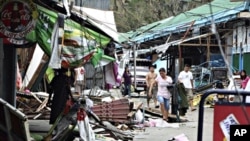Typhoon Megi is heading toward southern China after killing at least 13 people in the northern Philippines.
Chinese forecasters say the center of the storm is expected to pass between Hainan and Hong Kong islands on the way to the mainland Guangdong province. They say the typhoon will bring torrential rain to the province during the next few days.
Chinese official news agency Xinhua quotes local authorities as saying it is too early to tell where and when Megi will make landfall, but that central and western parts of the province are the most vulnerable. Thousands of people have been evacuated from Guangdong's coastal areas. Disaster officials have ordered civil affairs departments to prepare for relief operations.
In the Philippines, President Benigno Aquino said careful preparation kept the death toll relatively low after the typhoon swept over northern Luzon island.
U.S. Secretary of State Hillary Clinton expressed condolences to the Philippines for the damage and loss of life the storm caused.
Typhoon Megi flattened parts of Luzon island with winds of up to 225 kilometers per hour. It left in ruins many parts of Isabella province, the most populated in Luzon's Cagayan Valley. The storm uprooted trees, tore roofs from houses and destroyed crucial rice crops.
Thousands of people were moved into typhoon-safe buildings ahead of the storm, and rescue teams with emergency supplies were pre-positioned in critical areas.
Megi was the strongest storm to hit the Philippines in four years. It lost some of its force while crossing the mountains of Luzon, but is strengthening over the South China Sea.
China has issued warnings for Fujian, Guangdong, Guangxi and Hainan provinces as the country braces for possibly the biggest storm to hit China this year.
Typhoon Heads for South China After Striking Philippines
